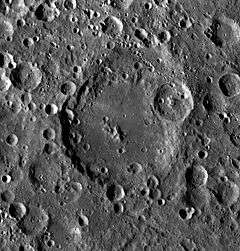Mach (crater)
|
LRO image | |
| Coordinates | 18°30′N 149°18′W / 18.5°N 149.3°WCoordinates: 18°30′N 149°18′W / 18.5°N 149.3°W |
|---|---|
| Diameter | 180 km |
| Depth | Unknown |
| Colongitude | 152° at sunrise |
| Eponym | Ernst Mach |


Mach is a large lunar crater of the class known as a walled plain. It is located on the far side of the Moon and cannot be viewed directly from the Earth. Nearby craters of note include Joule to the northeast, Mitra attached to the western outer rim, and Henyey to the southwest.
This is a prominent but eroded formation with multiple craters along the rim and interior. The crater Harvey breaks across the eastern rim, and its outer rampart spills across the interior floor of Mach. The overall shape of Mach resembles a pear, with a prominent outward bulge to the northeast. Such a bulge can be caused by a second, merged crater. The northern edge is also the most worn and overlain by impacts.
The interior of Mach is marked by several small craters, particularly in the northeastern bulge. Several craters also lie along the edges to the west and northwest. The remainder of the interior floor is relatively level, when compared to the terrain that surrounds Mach. There is a formation of central ridges near the midpoint of the crater.
Mach lies to the northeast of the Dirichlet–Jackson Basin.
Satellite craters
By convention these features are identified on lunar maps by placing the letter on the side of the crater midpoint that is closest to Mach.
| Mach | Latitude | Longitude | Diameter |
|---|---|---|---|
| H | 14.9° N | 144.1° W | 40 km |
References
- Andersson, L. E.; Whitaker, E. A. (1982). NASA Catalogue of Lunar Nomenclature. NASA RP-1097.
- Blue, Jennifer (July 25, 2007). "Gazetteer of Planetary Nomenclature". USGS. Retrieved 2007-08-05.
- Bussey, B.; Spudis, P. (2004). The Clementine Atlas of the Moon. New York: Cambridge University Press. ISBN 978-0-521-81528-4.
- Cocks, Elijah E.; Cocks, Josiah C. (1995). Who's Who on the Moon: A Biographical Dictionary of Lunar Nomenclature. Tudor Publishers. ISBN 978-0-936389-27-1.
- McDowell, Jonathan (July 15, 2007). "Lunar Nomenclature". Jonathan's Space Report. Retrieved 2007-10-24.
- Menzel, D. H.; Minnaert, M.; Levin, B.; Dollfus, A.; Bell, B. (1971). "Report on Lunar Nomenclature by the Working Group of Commission 17 of the IAU". Space Science Reviews. 12 (2): 136–186. Bibcode:1971SSRv...12..136M. doi:10.1007/BF00171763.
- Moore, Patrick (2001). On the Moon. Sterling Publishing Co. ISBN 978-0-304-35469-6.
- Price, Fred W. (1988). The Moon Observer's Handbook. Cambridge University Press. ISBN 978-0-521-33500-3.
- Rükl, Antonín (1990). Atlas of the Moon. Kalmbach Books. ISBN 978-0-913135-17-4.
- Webb, Rev. T. W. (1962). Celestial Objects for Common Telescopes (6th revised ed.). Dover. ISBN 978-0-486-20917-3.
- Whitaker, Ewen A. (1999). Mapping and Naming the Moon. Cambridge University Press. ISBN 978-0-521-62248-6.
- Wlasuk, Peter T. (2000). Observing the Moon. Springer. ISBN 978-1-85233-193-1.
